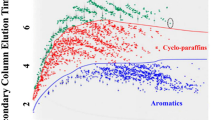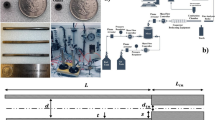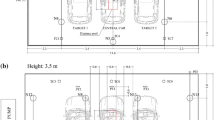Abstract
In order to utilize the low-calorific value gases, oxy-combustion technology is generally used to burn the diluted fuel mixture more efficiently, cleanly and safely. Here the thermal balance method is tailored to check the fuel mixture flammability with the help of theoretical flammability diagrams and non-dimensional HQR diagrams. Specifically, the contributions of diluent/oxidant/temperature are checked. Even with limited experimental data, they are found to be a powerful tool to understand the mixture flammability, since they are based on simple principles of energy conservation. This approach provides the foundation for fine-tuning safe operation parameters related to oxy-combustion technologies.





Similar content being viewed by others
Abbreviations
- \( C_{O} \) :
-
The oxygen coefficient in a reaction, dimensionless
- \( H_{O} \) :
-
The heating potential of oxygen based on air, dimensionless
- \( H_{F} \) :
-
The heating potential of fuel based on air, dimensionless, \( H_{F} = C_{O} H_{O} \)
- LFL:
-
Lower flammability limit (volume ratio), % or dimensionless
- \( Q_{D} \) :
-
The quenching potential of diluent based on air, dimensionless
- \( Q_{F} \) :
-
The quenching potential of fuel based on air, dimensionless
- \( Q_{O} \) :
-
The quenching potential of oxygen based on air, dimensionless, \( Q_{O} = 1.046 \)
- UFL:
-
Upper flammability limit (volume ratio), % or dimensionless
- \( x_{L} \) :
-
Lower flammability limit (volume ratio), % or dimensionless
- \( x_{U} \) :
-
Upper flammability limit (volume ratio), % or dimensionless
- R:
-
Diluent/fuel volumetric ratio
- LCVG:
-
Low-calorific value gas
- \( x_{D} \) :
-
Fraction of the second diluent (carbon dioxide) in the mixture
- \( x_{H} \) :
-
Fraction of hydrogen added to the fuel mixture
- \( x_{O} \) :
-
Fraction of oxygen in the fuel mixture
- \( \eta \) :
-
Fraction of enthalpy difference for a modified ambient temperature in reference to a normal ambient temperature
- L:
-
Lower flammable limit
- U:
-
Upper flammable limit
- LU:
-
Inertion point
- D:
-
Diluent-based potential to air potential
- F:
-
Fuel-based potential to air potential
- O:
-
Oxygen-based potential to air potential
- 0:
-
Initial state/concentration
References
Chomiak J, Longwell J, Sarofim A (1989) Combustion of low calorific value gases; problems and prospects. Prog Energy Combust Sci 15(2):109–129
Muniz L, Mungal M (1997) Instantaneous flame-stabilization velocities in lifted-jet diffusion flames. Combust Flame 111(1):16–31
Jones GW, Kennedy RE (1933) Limits of inflammability of natural gases containing high percentages of carbon dioxide and nitrogen. Washington: Bureau of Mines Report of Investigations
Chen L, Yong SZ, Ghoniem AF (2012) Oxy-fuel combustion of pulverized coal: Characterization, fundamentals, stabilization and CFD modeling. Prog Energy Combust Sci 38(2):156–214
Coward HF, Jones GW (1952) Limits of flammability of gases and vapors, DTIC Document
Burgess DS et al (1982) Flammability of mixed gases. Pittsburgh: Bureau of Mines
Heffington WM, Gaines WR, Renfroe DA (1984) Flammability limits of coal-derived low-btu gas mixtures containing large amounts of inert gases. Combust Sci Technol 36(3–4):191–197
Ma T (2013) A thermal theory for flammability diagrams guiding purge and inertion of a flammable mixture. Process Saf Prog 32(1):7
Ma T, Larranaga M (2014) Flammable state and dilution requirement for a gaseous mixture. Process Saf Prog 33(1):70–76
Ma T (2015) Engineering flammability for mixture safety. Springer (to be published)
Acknowledgments
The author would like to thank Mr. David Willson of Stanbridge Capital for introducing the topic of burning CO2-diluted methane safely. His curiosity, patience, and documents are deeply appreciated.
Author information
Authors and Affiliations
Corresponding author
Appendices
Appendix 1: Role of Diluent on the Flammability Envelope of Methane
For any low-calorific value gas mixtures, the diluent (mostly carbon dioxide) is changing the thermal signature of the fuel (combined into a pseudo fuel). For the diluted flammability diagram, a dilution ratio R is defined firstly as
This definition combined with a conservation equation \( x_{F} + x_{D} = x_{L} \).
Solve two equations for two variables, we have
Submitting them into the energy conservation equation at LFL, \( x_{F} \cdot Q_{F} + x_{D} \cdot Q_{D} + 1 - x_{L} = x_{F} H_{F} \), we have the thermal balance at critical flammability limits as shown below
where \( Q_{m} = Q_{F} \cdot \left( {1 - x_{D} } \right) + Q_{D} \cdot x_{D} \) is the quenching potential of the diluted fuel, \( H_{m} = H_{O} \) is unchanged, since the fuel type is the same. The total energy release is scaled down in \( C_{m} = C_{O} \cdot \left( {1 - x_{D} } \right) \).
Solve the above equations, we have the flammability envelope bounded by
Forcing \( x_{L} = x_{U} \), we have a crossing point (\( R_{LU} \), \( x_{LU} \)) which is the theoretical inertion point.
Appendix 2: Role of Oxygen on the Flammability Envelope of Methane
For an oxygen-modified air, the quenching potential of this mixture is defined by
where \( x_{O} \) is the mole fraction of oxygen in this nitrogen/oxygen mixture. If \( x_{O} = 0.2095 \), \( Q_{m} = 0.992 \times (1 - 0.2095) + 1.046 \times 0.2095 = 1 \), which is the normal air used as the reference species.
Following the thermal balance at LFL, we have the controlling LFL equation as
Similarly the governing equation for UFL is
Solve the above 3 equations, we have
Forcing \( x_{L} = x_{U} \), we have the cross point
Appendix 3: Temperature-Modified Flammability Diagrams
The temperature-dependence of thermal properties is established upon the enthalpy relationships between species provided by NIST chemistry webbook. Reconstruct a simpler correlation for air, we have the enthalpy of air determined by
Note the input is T/1000, so the coefficients can have more valid digits. Next, define a temperature-dependent enthalpy-scaling factor \( \eta (T) \) for measuring the system enthalpy change in reference to air.
For the thermal balance at LFL, we have
Rearrange the terms, we have a new equation for LFL with R as the only input.
Similarly, we can solve
Then, we have a new temperature dependent equation for UFL
Forcing\( x_{L} = x_{U} \), we have the cross point
For mixtures without dilution (R = 0), we have the flammability range defined by
Note, the equivalence ratio is defined as
Rights and permissions
About this article
Cite this article
Ma, T., Larranaga, M. Theoretical Flammability Diagrams for Oxy-combustion. Fire Technol 52, 321–331 (2016). https://doi.org/10.1007/s10694-015-0463-4
Received:
Accepted:
Published:
Issue Date:
DOI: https://doi.org/10.1007/s10694-015-0463-4




